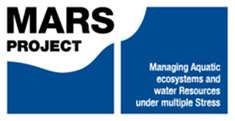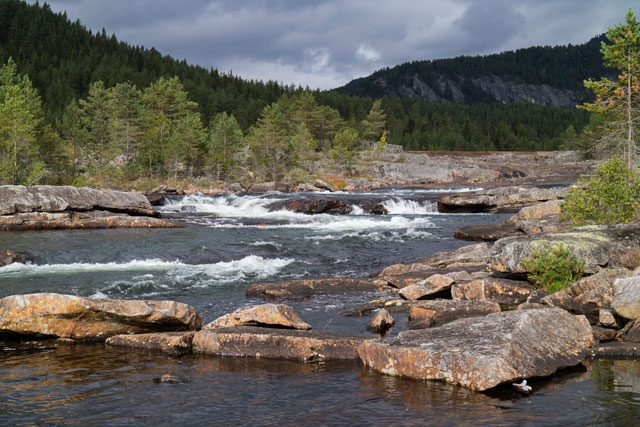Key findings
- Runoff in the Otra basin is predicted to increase over the next 90 years as the result of climate change, with winter runoff projected to increase and summer runoff projected to decrease.
- Future climate change will cause a small improvement in water chemistry over the coming decades, even if acid deposition continues at present levels, as a result of dilution due to increased runoff.
- If populations of salmon in the Otra are to benefit from reduced acidification, management should promote their genetic integrity and reproductive success through strategies such as fish passes on hydropower projects.
Water management issues
Only 32% of the 249 streams in the Otra basin were found to have good or very good ecological status in 2013 EU Water Framework Directive sampling. Similarly, only 34% of the 77 lakes in the basin had good or very good status. The key pressures causing poor ecological status in the basin are acid deposition, hydropower development, and to a lesser extent the spread of non-native plant and fish species. The basin’s geology, siliceous bedrock and thin and patchy soils, with very low rates of chemical weathering, makes the river vulnerable to acid deposition, which peaked in the 1970s and has subsequently reduced.
Around 40% of the basin’s drainage area has been hydrologically altered for electricity production, and 52 of the basin’s water bodies are classified as ‘heavily modified’ due to hydropower development. The resulting hydromorphological alterations have caused major impacts on basin discharge, river morphology (e.g. channelisation, dredging, and building of weirs) and water quality. Climate change is an increasingly significant driver of ecological change in the basin, through altered precipitation, snowmelt and temperature patterns.
Environmental storylines and scenarios
The MARS study in the Otra basin sought to understand how future acid deposition and climate change will affect water chemistry and fish populations in the Otra River. Variations in air temperature, precipitation, discharge, water chemistry and fish catch were modelled under two trajectories for future climate change.
These climate scenarios were based on the Representative Concentration Pathways adopted by IPCC, and model moderate (RCP 4.5) and extreme (RCP 8.5) climate changes. Three scenarios for acid deposition were used: NAT, where national and international agreements for limiting future emissions of acidifying compounds have been made; MFR, reflecting maximum feasible reductions in emissions, and; CONST, which is continued deposition at 2010 levels.
Results and conclusions
Findings of scenario analysis
Both climate models projected increased runoff in the upper Otra river basin over the next 90 years. The magnitude of change increases with time, and the larger RCP projects a larger increase in runoff. The seasonal pattern of runoff was projected to change: winter runoff was projected to increase while summer runoff was projected to decrease. The two climate models differed in that the GFDL model indicated higher runoff in April and May (spring snowmelt) whereas the IPSL model indicated higher runoff in mid-winter.
Projections suggest that future climate change will give a small but measurable improvement in water chemistry over the coming decades, even if acid deposition continues at present levels. This is due to increased runoff and discharge diluting acid anions. As expected, the poorest water quality is under the CONST scenario, and the best under MFR. Significantly, scenarios with climate change projected slightly better water chemistry conditions, compared to those with no climate change. In other words, climate change may moderately mitigate the ecological impacts of acid deposition in the Otra in the future.
Multi-stressor interactions
Both the landlocked salmon in Lake Byglandsfjord and the anadromous salmon in the lower reaches of the Otra River have been impacted by acid water. The various life stages of salmon have different thresholds for damage. The most sensitive life stages are juvenile salmon (parr) and the smoltification period in the spring. As such, pH thresholds (below which the fish would be exposed to physiological stress) were set at different levels for different life stages, which occur at different parts of the river: pH 5.8 for parr (bleke at Ose and Evje) and 6.2 for smolt (anadromous salmon at Skråstad).
The results are thus split by site and life stage. At Ose, at present about 8% of months have mean pH below the threshold of 5.8; the NAT scenario improved the situation (but still with months below the threshold), whilst the MRF scenario removed acidification stress entirely. At Evje, at present only about 3% of months have pH below the pH 5.8 threshold; but in all future climate and acid deposition scenarios the monthly mean pH is always be above the threshold, similarly rem the effects of acidification. At Skråstad, at present almost 100% of months are below the 6.2 pH threshold for smolt, indicating significant acidification stress. Modelling results suggest that climate change will improve the situation, but deposition reductions beyond the NAT scenario are necessary to reduce the toxicity of water to anadromous salmon.
Significance for water management
The modelling results suggest that future reductions in acid deposition will yield improvements in water quality, which are aided by increased dilution of acid anions by increased precipitation and runoff in a changing climate. The problem of acid river water will be helped at Ose, essentially solved at Evje, but remain substantial at Skråstad. Acid deposition will become less important, but still not negligible, and the river will probably always have pH levels near the critical pH thresholds. Current remedial measures for acidification include the liming of acidified water bodies and continued international negotiations to reduce emission of air pollutants.
Hydropower is a significant pressure interacting in tandem with acidification and climate change. Hydropower operations alter river water temperature, discharge and connectivity which in turn affects the migration, spawning and hatching phases of the salmon life cycle. As a result, if the Otra salmon populations are to benefit from reductions in acidification, river basin management which ensures their genetic integrity and reproductive success – through strategies such as fish passes – are important.
Basin overview
The Otra River is the largest in southernmost Norway and drains around 4000 km2 of forest and alpine uplands. Its catchment is long and narrow, running north to south to the North Sea at Kristiansand. The Otra River has been extensively developed for hydro-electricity production since 1905, causing extensive channel and flow modifications through dams, tunnels and basins. The basin is characterised by siliceous bedrock and thin and patchy soils, with very low rates of chemical weathering, which makes the Otra vulnerable to acid deposition. The river holds unique populations of land-locked salmon and anadromous salmon in the lower reaches, which have both been severely affected by acidification.
Context for modelling
Two global climate models – GFDL (developed by the Geophysical Fluid Dynamics Laboratory) and IPSL (developed by the Institute Pierre Simon Laplace) – were used to model changes in temperature and precipitation. The outputs of these fed into a rainfall-runoff model PERSIST, which generates daily discharge at the basin scale. The river basin was split into five sub-basins, and the models calibrated for each using historical discharge data from 1965-2014. The discharge outputs from PERSIST were fed into a geochemistry model, MAGIC, which is used to predict the long-term effects of acid deposition on soil and surface water chemistry. PERSIST simulates the mass balance of acidic ions by simulating ionic fluxes from atmospheric inputs, chemical weathering, net uptake in biomass, and loss to runoff. MAGIC was calibrated to each of the five sub-basins.
Materials and methods
Five sampling sites along the river provided hydrological (50 year timescale) and another five sites provided water chemistry (30 year timescale) data, held by the Norwegian Institute for Water Research. Fish catch data was taken from historical fishing samples and reports. Meteorological data such as precipitation and temperature were provided by the Norwegian Water Resources and Energy Directorate. Soil data was taken from two well-studied small catchments in the area, Storgama and Birkenes. Deposition of major chemical components is measured by the Norwegian Institute for Air Research at two stations within or near the Otra River catchment, with longer-term data supplied by the Coordinating Center for Effects (CCE), part of the United Nations Economic Council for Europe’s (UN-ECE) Convention on Long Range Transboundary Air Pollution (LRTAP).
Facts and Figures: OTRA
- Factors affecting measured runoff:
Discharge at the river mouth is set to minimum 50 m³/sec as a legal requirement to the power company. Discharge along the entire length of the river and in many of the tributaries is subject to operations of the hydropower installations. - Key stakeholders:
- Sport and commercial fishermen
- General public (tourism and recreational activities)
- Forest owners and farmers
- Electricity companies
- Drinking water suppliers
- Contact person: Raoul-Marie Couture, NIVA
Further reading
MARS Deliverables:
MARS (2017) Case study Otra - Case Study Synthesis - Deliverable 4.1. (Download report, 26.1mb)
Scientific articles and reports:
Kroglund F, Kaste O, Rosseland BO, Poppe T. 2001. The return of the salmon. Water Air and Soil Pollution. 130: 1349-1354. DOI: 10.1023/A:1013918325941 (Read abstract)
Kroglund F, Høgberget R, Hindar K, Østborg G, Balstad T. 2008. Salmon and water quality in the Otra River, 1990-2006. NIVA Report 5531-2008. Norwegian Institute for Water Research, Oslo, Norway. (Download report, 1.75mb - in Norwegian)
Wright R.F., Couture R.M., Christiansen A.B., Guerrero J.L., Kaste Ø., Barlaup B.T. 2017. Effects of multiple stresses hydropower, acid deposition and climate change on water chemistry and salmon populations in the River Otra, Norway. Science of the Total Environment; 574: 128-138. DOI: 10.1016/j.scitotenv.2016.09.044 (Read abstract)
Websites:
Freshwaterblog (2016) Multiple stressors in Science of the Total Environment: Effects of multiple stresses hydropower, acid deposition and climate change on water chemistry and salmon populations in the River Otra, Norway (external website)
Vest-Adger Fi. 2009. Management Plan for Water Region Southwest. Water district Otra and Figgjo 2010-2015, 2009, pp. 85. (external website, in Norwegian)






.jpg)

